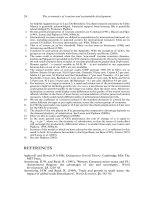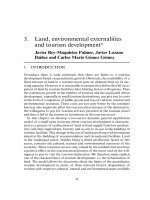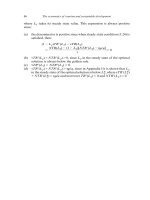THE ECONOMICS OF MONEY,BANKING, AND FINANCIAL MARKETS 421
Bạn đang xem bản rút gọn của tài liệu. Xem và tải ngay bản đầy đủ của tài liệu tại đây (47.75 KB, 1 trang )
CHAPTER 15
Central Banks and the Bank of Canada 389
THE CHAN G IN G FACE OF T HE BAN K O F CA NADA
The legislation governing the Bank of Canada s responsibility for monetary policy
has remained relatively unchanged since the Bank Act of 1967. Over the past
decade, however, the Bank has undertaken a broad range of initiatives and made
significant institutional changes to the way it operates. The impetus for change
came from the interaction of experience and economic theory, the desire to
explain and build confidence in the Bank s actions, and (to a smaller extent) from
technological change and globalization.
Clarifying objectives is an important starting point for any successful monetary
policy framework. The legislation by which the Bank of Canada is governed does
not facilitate a clear understanding of objectives. For example, the preamble to legislation governing the Bank refers to multiple, and potentially inconsistent, policy
objectives. Over the past few decades, however, the performance of the Canadian
economy, together with the evolution of economic theory, led to the view that
price stability is the most important goal of monetary policy. As John Crow put it,
in his January 1988 Hanson Memorial Lecture at the University of Alberta,
[t]heory and experience much of this experience not overly cheerful but certainly
instructive both point to a very clear answer. Monetary policy should be conducted so
as to achieve a pace of monetary expansion that promotes stability in the value of
money. This means pursuing a policy aimed at achieving and maintaining stable prices. 8
The Hanson lecture was designed to explicitly identify price stability as the
objective of Bank of Canada policy. This message was reinforced on February 26,
1991, through a joint announcement by the governor of the Bank and the minister of finance regarding the establishment of formal inflation targets (to be discussed in detail in Chapter 18). Clearly defined targets can be appealed as an
institutional way of improving the macroeconomic outcomes of monetary policy.
The effectiveness of such an institutional framework, however, depends on two
fundamental requirements: independence and accountability. Although the Bank
of Canada has not been given goal independence the goal of price stability has
been set jointly by the Bank and the Department of Finance over the last decade
the Bank placed increased emphasis on its responsibility to achieve the goal of price
stability and its greater freedom to take whatever action is needed to do so. This freedom is referred to as operational (or instrument ) independence and, although it
hasn t been explicitly legislated, it exists in practice. Increased operational independence has also raised the standards for accountability. As already noted, for example, the governor of the Bank has delegated the authority for monetary policy
decisions to a committee the six-member internal Governing Council. Moreover, it
has become a de facto standard for the governor to appear before a parliamentary
committee following the release of the Bank s Monetary Policy Report.
The Bank of Canada has also improved its communications activities by moving
towards greater transparency in its operations and objectives. In 1999, for example,
the Bank started a twice-yearly Update to the Monetary Policy Report, both published
by the Bank s Governing Council. The Monetary Policy Report is published every
April and October while the Update is published every January and July, giving an
account of the Bank s management of monetary policy. Moreover, the Bank has
noticeably increased the number of press conferences, press releases, and speeches,
and also reorganized its regional offices in 1996 1997 with the objective of improv8
John Crow, The Work of Canadian Monetary Policy, The Eric J. Hanson Memorial Lecture, University
of Alberta, Edmonton, Alberta. Bank of Canada Review (1988): 3 17.









